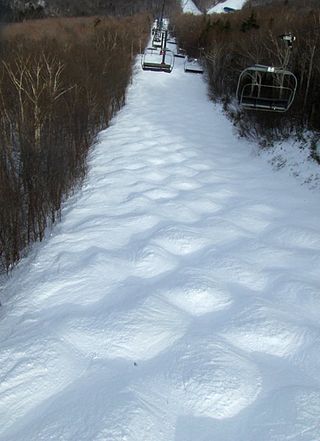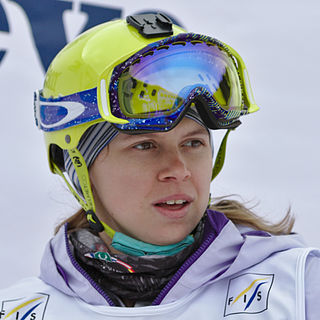Freestyle skiing is a skiing discipline comprising aerials, moguls, cross, half-pipe, slopestyle and big air as part of the Winter Olympics. It can consist of a skier performing aerial flips and spins and can include skiers sliding rails and boxes on their skis. Known as "hot-dogging" in the early 1970s, it is also commonly referred to as freeskiing, jibbing, as well as many other names, around the world.

Freestyle skiing has been contested at the Winter Olympic Games since the 1992 Winter Games in Albertville, France.

Mogul skiing is a freestyle skiing competition consisting of one timed run of free skiing on a steep, heavily moguled course, stressing technical turns, aerial maneuvers and speed. Internationally, the sport is contested at the FIS Freestyle World Ski Championships, and at the Winter Olympic Games.
The freestyle skiing competition of the 2010 Winter Olympics was held at Cypress Mountain. The events took place between the 13 and 25 February 2010, and included a new event for these Olympics, ski cross.

Alexandre Bilodeau is a Canadian retired freestyle skier from Rosemere, Quebec, Bilodeau currently resides in Montreal, Quebec. Bilodeau won a gold medal in the men's moguls at the 2010 Winter Olympics in Vancouver, becoming the first Canadian to win a gold medal at an Olympic Games held in Canada. At the 2014 Winter Olympics, he became the first Olympian in history to defend his gold medal in any freestyle skiing event as well as the first Canadian to defend an individual title since Catriona Le May Doan at the 2002 Winter Olympics. Bilodeau is a three-time FIS World Champion in dual moguls, and is also a two-time Worlds silver medallist in moguls. He was the FIS World Cup champion for the 2008–09 season winning the moguls and overall freestyle skiing title that season. In his final World Cup race, he retired with a win, and in doing so, surpassed Jean-Luc Brassard for the most World Cup medals by a Canadian.

Patrick Deneen is an American freestyle skier, specializing in moguls. Deneen was the gold medalist at the 2009 International Ski Federation (FIS) Freestyle World Ski Championships. In December 2009, Deneen won the US Olympic trials, held at Steamboat Springs, Colorado, securing a spot on the US Olympic Team for the 2010 Winter Olympics in Vancouver. In FIS World Cup events, he has reached the podium at 4 events in 25 starts, and was the 2008 Freestyle Rookie of the Year.
Michael Morse is an American freestyle skier who has competed since 1997. His best World Cup finish was third, which was in a moguls event in Norway in 2009.
Nathan "Nate" Roberts is an American freestyle skier who has competed since 1999. He won two medals at the FIS Freestyle World Ski Championships with a gold in 2005 and a bronze in 2007.

Mikaël Kingsbury is a freestyle skier from Quebec. He is the most accomplished mogul skier of all time. He achieved eminence early in his career after earning the 2009–10 FIS World Cup Rookie of the Year award. He is a ten-time FIS Freestyle World Cup title-holder for overall moguls and nine-time title-holder for overall freestyle, owning the records for most men's Moguls World Cup titles and Overall Freestyle World Cup titles. He also owns the records for career World Cup moguls victories with 78, and consecutive Freestyle World Cup event wins with 13. He is the first man to have won both the moguls and dual moguls World Championship events, and has won the most medals at the Freestyle World Championships of any male competitor in history, having won a medal in 13 of the 14 events he has competed in. Kingsbury won the Olympic silver medal in 2014 and 2022, and, at the 2018 PyeongChang Winter Olympics, he won the gold medal in men's moguls.

Justine Dufour-Lapointe is a Canadian freestyle skier. She was the Olympic champion in the moguls event at the 2014 Winter Olympics and won a silver medal in moguls at the 2018 Winter Olympics. The gold and silver she and her sister Chloe Dufour-Lapointe won in 2014 was the first time that Canadian sisters stood together on the podium, and the fourth time ever by all nations. In winning the Olympics, she became the youngest freestyle skiing Olympic champion ever at nineteen years of age. Dufour-Lapointe was the FIS World Cup rookie of the year for the 2010–11 season. Dufour-Lapointe was the world champion in moguls at the 2015 World Championships has also won a silver and two other bronze medals in the moguls event at the Freestyle World Ski Championships.

Britteny Cox is an Australian mogul skier. Growing up in the Victorian alpine resort of Falls Creek, Cox was born into a mogul skiing environment, with her family passionate mogul skiers.
Jillian Rachell Vogtli was a two-time Olympian and athlete on the U.S. Ski Team; she competed in the freestyle skiing events of moguls and dual moguls.

Yulia Evgenievna Galysheva is a Kazakhstani mogul skier who won three medals at FIS Freestyle Ski World Championships, bronze medal at the 2018 Pyeongchang Olympic Games and two gold medals at the Asian Winter Games in 2011.
Ski ballet is a form of ballet performed on skis. It is very similar to figure skating, combining spins, jumps, and flips in a two-minute routine choreographed to music. It was part of the professional freestyle skiing tours of the 1970s and 1980s and then an official FIS and Olympic discipline until the year 2000. Ski ballet became known as Acroski in the 1990s in an effort to legitimize its place among the competitive ski community, especially to the FIS. It is no longer a part of competitive freestyle skiing.

Switzerland competed at the 2018 Winter Olympics in Pyeongchang, South Korea, from 9 to 25 February 2018, with 166 competitors in 14 sports. They won 15 medals in total, ranking 7th in the medal table.
The men's moguls competition in freestyle skiing at the 2022 Winter Olympics were held on 3 February (qualification) and 5 February (final), at the Genting Snow Park in Zhangjiakou. Walter Wallberg of Sweden won the event. Mikaël Kingsbury of Canada became the silver medalist, and Ikuma Horishima from Japan took the bronze. For Wallberg and Horishima this is the first Olympic medal.
The women's moguls competition in freestyle skiing at the 2022 Winter Olympics was held on 3 February (qualification) and 6 February (final), at the Genting Snow Park in Zhangjiakou. Jakara Anthony of Australia won the event, with Jaelin Kauf of the United States taking silver and Anastasia Smirnova, representing the Russian Olympic Committee, bronze. For all of them this is the first Olympic medal. Antony's medal is the first Olympic medal for Australia in women's moguls.

Cole McDonald is an American freestyle skier. He joined the US Ski & Snowboard's U.S. Freestyle Ski Team in July 2021. In the same season as his first World Cup, he earned a spot on the U.S. Men's Moguls Team at the 2022 Winter Olympics in Beijing, making him the youngest American male mogul skier to participate in the Olympics at 18 years of age. McDonald was named World Cup Rookie of the Year in 2022.
Benjamin "Ben" Ogden is an American cross-country skier. He has been a member of the U.S. Cross Country Ski Team since 2019. Ogden made history in 2018 at the FIS Junior World Ski Championships in Goms, Switzerland, when he and his teammates secured a silver medal in the junior men's relay, which was the first ever medal for the U.S. men at a World Juniors Championship event.










